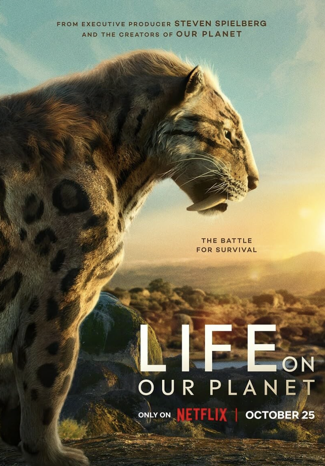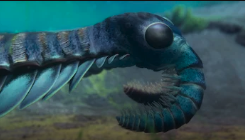“Life on Our Planet” offers Ancient Wildlife and Evolution: A Spectacular Nature Series on Netflix

Ever since the late 70s, when on Sunday nights the place to be was at home watching PBS, I have loved nature shows. At that time PBS’ Nature had surpassed Marlin Perkins, Wild America, and even National Geographic in terms of stunning cinematography.
I’d always liked animal shows, and Jacques Cousteau’s specials were never-to-be-missed, but Nature was in a class by itself. It may still be, but I’ve left television shows far behind. Once I graduated college and joined the real world, life became too busy and, frankly, more interesting. Somewhere in the 80s I stopped watching completely.
Then came the Aughts, Netflix, and extra time on my hands. Life changed. Binge-watching was in. Independent movies became available. And TV evolved far beyond the networks.
Recently I’ve returned to nature shows. It started with “My Octopus Teacher,” depicting the relationship between one human and a soulful octopus. I cried. Then I discovered David Attenborough. He’s been busy and I’ve had a hard time catching up. Now there’s Morgan Freeman’s distinct voice explaining evolution, and Spielberg executive producing “Life On Our Planet.” Imagine the advanced tech work of Jurassic Park as back drop for a documentary story spanning billions of years. That gives you the idea. “Amazing” doesn’t do it justice.
The fantastic visuals include beasts that I had here-to-fore never heard of, let alone seen images of. Apparently our planet has experienced five mass extinctions, not just the one from the asteroid that killed all the dinosaurs. This series brings to life all those previous eras and the prehistoric animals and plants that inhabited them.
It’s not just the usual suspects: stegosaurs, brontosaurs, and T. Rex. We find terrabirds, smiladons, myasaurs, and so much more. The series starts with the first single cell we supposedly all came from. From there the first episode did a quick round up of what’s been happening since that lonely blob, accentuating the rules of life: 1) the fittest, i.e., best adapted, will survive; 2) there is competition between species as well as between individuals within a species; 3) Earth never stays the same so habitats change and pressure mounts. Go back to rules 1 and 2 to see the result. It all boils down to this: when conditions change and food gets scarce, only the ones who can adapt will survive.
 Anomalocaris, (“weird shrimp”) one of the earliest predators ever known.
Anomalocaris, (“weird shrimp”) one of the earliest predators ever known.The story goes back and forth between prehistoric epochs and modern times. We see how and where the ancient ones lived. And died. Interspersed are episodes of modern animals that inhabit the same niche as the older extinct animals. Like how ages and ages ago, anomalocaris was the apex predator, while today Carcharodon (shark) rules the sea. It’s a great way to illustrate what went on long before we arrived, giving us a chance to see what we could otherwise only imagine.
The series is filled with fun facts, such as how moss ruled the planet for 40 million years. That’s a lot of time before plants evolved beyond a single layer! Earth was seemingly covered with nothing but a big green carpet.
The images of the ancient animals are a bit herky jerky in the same way the dinosaurs in Jurassic Park don’t move in quite a natural way. It stands out compared to the actual footage of today’s animals, but you do get a good feel for how things looked.
If nothing else, the series gives one hope for the future. There have been numerous mass extinctions in the past, and life survived. Presumably then, the one we are undergoing right now will one day pass as well. Hopefully we’ll be able to ride it out, but one never knows.
 Anchiornis, one of the earliest birds, still half dinosaur at this point.
Anchiornis, one of the earliest birds, still half dinosaur at this point.The show is educational and extremely beautiful. What a combination! I look forward to watching it all again. Probably tomorrow. Just because I can. It’s the 21st Century, after all: whatever I want to consume is available, 24/7.
Fun fact: the mnemonic to memorize the six names of the periods of the Paleozoic Era (Cambrian, Ordovician, Silurian, Devonian, Carboniferous, Permian) is “clammy oysters slide down Cathy’s pockets.” See how much fun Paleontology is! Thank you Mr. Bowen and Intro to Geology 101 for that.
Go enjoy some graphics of the home planet from a time long before you or anyone else was ever born.
Sue Lange, author WE, ROBOTS (or, How I learned to love the robot overlords).Sue Lange's Blog
- Sue Lange's profile
- 19 followers



